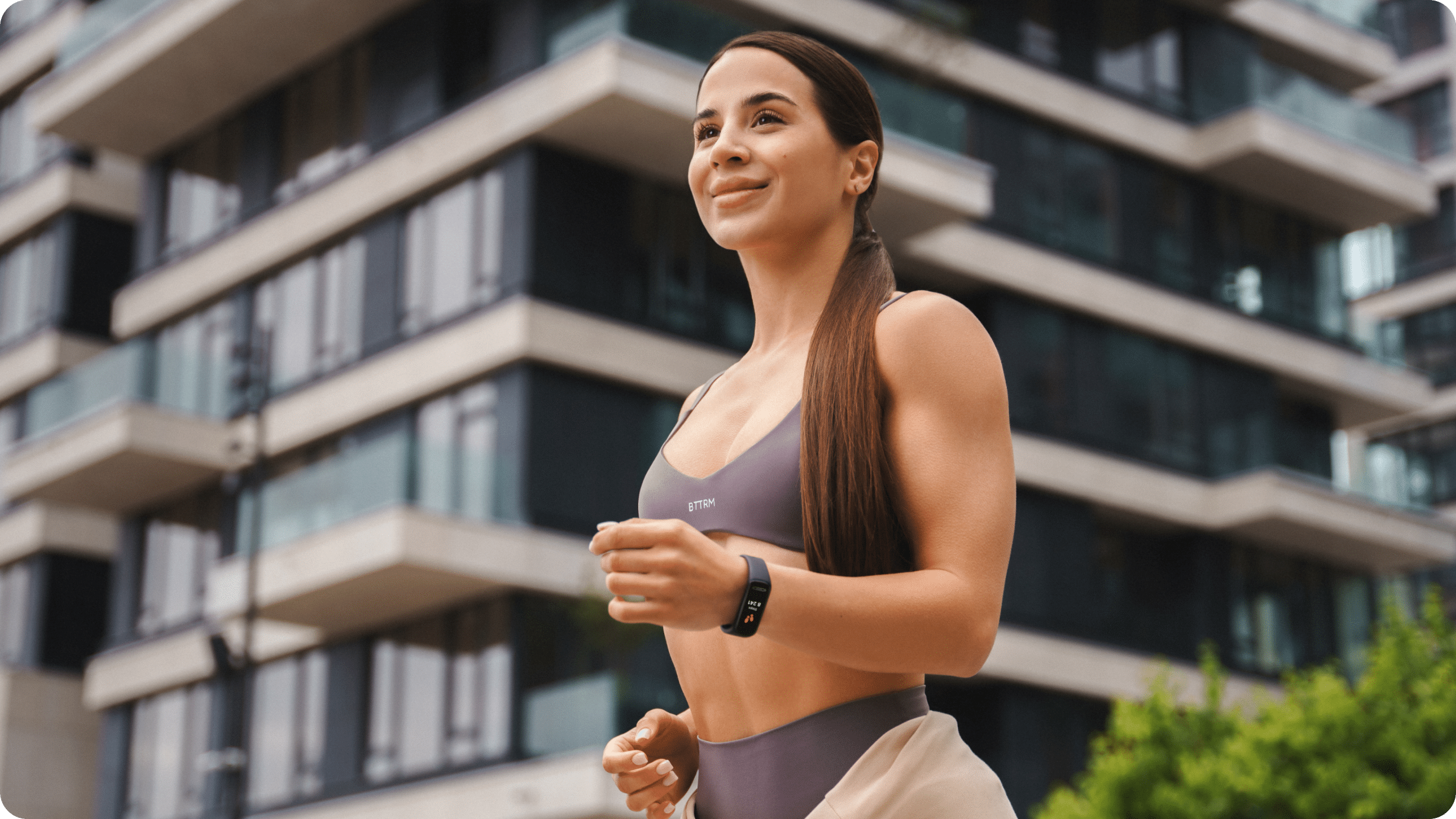Walking has a lot of calorie-burning potential. According to the American Council on Exercise, an individual can burn anywhere between 60 and 100 calories per mile walked, depending on their weight and walking speed (4). Yet, this is a rough estimate, and many factors can influence the true caloric expenditure. In this guide, we delve deeper into these variables to provide a more comprehensive understanding of how walking can contribute to your health and fitness goals. We’ll explore how factors such as body weight, walking pace, terrain, and even the weather can affect the number of calories you burn during a 1-mile walk. This article is not just about numbers; it’s about helping you make the most out of every step.
How Many Calories Do You Lose Walking 1 Mile?
The number of calories you burn while walking a mile can depend on various factors like your body weight, age, sex, and the pace at which you’re walking.
- Body Weight: The more you weigh, the more calories you’re likely to burn while walking. This is because it takes more energy to move a larger body mass.
- Walking Speed: The faster your pace, the more calories you’ll burn in a given period. This is because you’re covering more distance and your body needs to work harder.
- Terrain: Walking uphill or on uneven terrain can also burn more calories than walking on a flat surface. This is because your body has to work harder to maintain balance and propel itself uphill.
- Intensity: Incorporating periods of high-intensity exercise, like brisk walking or jogging, can help increase calorie burn.
- Walking Technique: A proper walking technique can engage more muscles and increase the number of calories burned. This includes maintaining good posture and using arm movements.
Here’s a basic breakdown based on pace:
- Slow pace (2 mph): A person weighing around 150 lbs would burn approximately 64 calories walking one mile.
- Moderate pace (3 mph): A person of the same weight could burn around 85 calories per mile.
- Brisk pace (4 mph): A person with the same weight might burn close to 95-100 calories.
- Very brisk pace (5 mph): The calorie burn could increase to 115-120 calories per mile.
Read More: How Many Calories Does 100 Squats Burn?
How Many Calories Burned Walking 2 Miles ?
The number of calories burned while walking two miles can vary; here’s a general estimate based on pace:
- Slow pace (2 mph): A person weighing around 150 lbs might burn approximately 128 calories walking two miles.
- Moderate pace (3 mph): The same person could burn around 170 calories for two miles.
- Brisk pace (4 mph): The calories shred by the same person can increase to about 190-200 calories for two miles.
- Very brisk pace (5 mph): The calorie burn could rise to approximately 230-240 calories for the same distance.
How Many Calories Do You Burn Walking 10,000 Steps?
The number of calories burned by walking 10,000 steps can vary based on several factors such as your weight, pace, and the terrain you’re walking on.
However, on average, most people burn between 300 and 400 calories by walking 10,000 steps.
This is based on the estimate that a person will typically burn between 30 and 40 calories per 1,000 steps.
Keep in mind that these numbers are averages and the actual calorie burn can vary. For instance, heavier individuals or those who walk at a brisker pace are likely to burn more calories.
Another factor that can influence calorie burn is the terrain. Walking on an incline or over rough terrain can increase your caloric expenditure while walking over flat ground or on a treadmill may reduce it.
How Many Miles Is A 500-Calorie Walking?
The number of miles it takes to burn 500 calories depends on several factors, including your body weight and the pace at which you walk. Generally speaking:
- If you weigh around 125 pounds and walk at a speed of 3.5 miles per hour, you would need to walk for approximately 111 minutes to burn 500 calories, which is about 6.5 miles.
- For someone who weighs around 155 pounds and walks at a speed of 4 miles per hour, it would take roughly 90 minutes to burn 500 calories, which equates to about 6 miles.
BetterMe app is a foolproof way to go from zero to a weight loss hero in a safe and sustainable way! What are you waiting for? Start transforming your body now!
How To Maximize Calorie Burn While Walking?
Maximizing your calorie burn while walking involves incorporating strategies that increase your heart rate and engage more muscle groups. Here are eight tips to help you get the most out of your walks:
Add Short Jogs Or Runs
Incorporating short jogs or runs into your walking routine can significantly enhance your calorie-burning potential. This technique is known as high-intensity interval training (HIIT) (2).
By alternating between periods of high-intensity jogging or running and low-intensity walking, you not only increase your heart rate but also stimulate your metabolism, leading to higher calorie burn during and even after the exercise. This is due to the “afterburn effect” or excess.
Post-exercise oxygen consumption (EPOC), where your body continues to burn calories at a higher rate as it recovers from the intense exercise (1). To incorporate this into your walking routine, start by jogging or running for 30 seconds to a minute, then slow down to a walk to recover, and repeat.
Practice Active Walking
Active walking involves engaging your core muscles and using proper arm motion while walking. By tightening your abs and swinging your arms in sync with your stride, you can improve your balance, increase your pace, and engage more muscles, leading to a higher calorie burn.
Proper form is important here to prevent injuries and maximize efficiency. Keep your back straight, look ahead, roll through your foot from your heel to toe, and swing your arms freely with elbows bent at about 90 degrees. Practicing active walking will not only help you shed more calories but also enhance your overall fitness and muscle tone.
Track Your Progress
Using a fitness tracker or a smartphone app to monitor your steps, distance covered, and estimated calories burned can be a motivational tool and help you stay on track. Many people find that setting goals and tracking their progress over time encourages them to walk more and push harder.
Plus, seeing your improvement over time can provide a sense of accomplishment and motivation to maintain or increase your efforts. Remember that these devices provide estimates and may not be 100% accurate, but they can give you a good idea of your activity level and progress.
Wear Proper Footwear
The importance of wearing the right shoes when walking can’t be overstated. Comfortable, well-fitted, and supportive shoes can help prevent foot and leg discomfort or injuries.
They can also improve your gait and walking speed, contributing to a more efficient and productive walk. Look for shoes with good arch support, a slightly elevated heel, and enough room for your toes to wiggle.
Keep in mind that everyone’s feet are different, so what works for one person might not work for another. It’s worth taking the time to try on several pairs and find the right fit for your feet.
Read More: The Best Beach Workout Equipment For Maximizing Your Seaside Sweat Sessions
Dress Appropriately
Dressing appropriately for the weather and environment can make your walks more comfortable and enjoyable. In hot weather, wear light, breathable clothing to help keep you cool. In colder temperatures, layer your clothing so you can adjust as needed.
A waterproof jacket can be useful if you’re walking in wet conditions. Remember to protect your skin with sunscreen and wear a hat or sunglasses for protection from the sun.
Stay Hydrated
Hydration is key to maintaining energy levels and preventing fatigue during your walks (3). Ensure you drink plenty of water before, during, and after your walk, especially in hot weather or during long walks. Bringing a water bottle with you can help remind you to drink regularly.
Warm Up And Cool Down
Always take the time to warm up before you start your walk and cool down afterward. Warming up increases blood flow to your muscles and helps prevent injury while cooling down helps your heart rate and breathing return to normal gradually, reducing stress on your heart. Both can contribute to a more comfortable and efficient walking routine (5).
Frequently Asked Questions
How Many Calories Do You Burn Walking Half A Mile?
On average, a person burns about 50-70 calories walking half a mile. The exact number can vary based on factors such as your weight, pace, and the terrain you’re walking on.
Intense sweat sessions, working weight loss tips, lip-smacking recipes come in one package with the BetterMe app. And all of it is at your fingertips, start transforming your life now!
How Many Calories Are Burned Walking 1 Mile In 20 Minutes?
If you walk a mile in 20 minutes, you could burn approximately 80-100 calories. This estimation can vary depending on factors like your weight and the intensity of your walk.
Is Walking 1 Mile A Day Good For Weight Loss?
Yes, walking 1 mile a day can contribute to weight loss over time when combined with a healthy diet. It’s a form of moderate exercise that can help you burn extra calories and improve heart health. However, the amount of weight you can lose from walking will depend on factors like your current weight, diet, and the pace of your walk.
The Bottom Line
Understanding the calorie burn from walking can help you manage your weight and improve overall fitness. Walking 1 mile can burn around 80-100 calories, depending on various factors such as your weight and pace. Incorporating regular walking into your daily routine is a simple and effective way to increase your physical activity and contribute to a healthier lifestyle.
DISCLAIMER:
This article is intended for general informational purposes only and does not serve to address individual circumstances. It is not a substitute for professional advice or help and should not be relied on for making any kind of decision-making. Any action taken as a direct or indirect result of the information in this article is entirely at your own risk and is your sole responsibility.
BetterMe, its content staff, and its medical advisors accept no responsibility for inaccuracies, errors, misstatements, inconsistencies, or omissions and specifically disclaim any liability, loss or risk, personal, professional or otherwise, which may be incurred as a consequence, directly or indirectly, of the use and/or application of any content.
You should always seek the advice of your physician or other qualified health provider with any questions you may have regarding a medical condition or your specific situation. Never disregard professional medical advice or delay seeking it because of BetterMe content. If you suspect or think you may have a medical emergency, call your doctor.
SOURCES:
- 7 Things to Know About Excess Post-exercise Oxygen Consumption (EPOC) (2014, acefitness.org)
- HIIT (High Intensity Interval Training) (2021, harvard.edu)
- THE IMPORTANCE OF HYDRATION DURING EXERCISE (2020, fitnesseducation.edu.au)
- Tools & Calculators (n.d., acefitness.org)
- Why Warming Up and Cooling Down is Important (2016, tricitymed.org)















